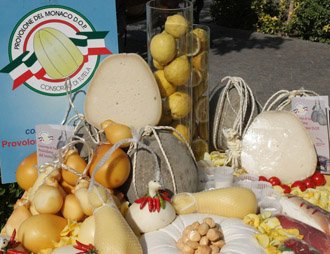Provolone cheese
Provolone cheese is a semi-hard cheese that originated in southern Italy made from unpasteurized cows milk. It is a type of pasta filata cheese, which means it is made by stretching the curd during the cheesemaking process.
Provolone has a pale yellow to white color and a slightly sharp, nutty flavor. It comes in different varieties, including Provolone dolce (sweet), Provolone piccante (spicy), and smoked.
Provolone del Monaco (meaning "monk's provolone"; from the Naples area of Italy) has received a Protected Designation of Origin (PDO) from the European Union.
 |
| Provolone del monaco. Courtesy: Ago press |
Production of Provolone cheese:
Provolone cheese originated in southern Italy, and it is now also produced in other parts of the world.
Procedure:
- Milk is heated and then coagulated using a starter culture and rennet, which causes the milk proteins to form curds.
- The curd is cut into small pieces and then heated again to expel whey, which is the liquid part of the milk.
- The curd is then molded into the characteristic provolone shape, either using a special mold or by hand. The cheese can be made in various sizes, from small, individual-sized portions to large, sausage-shaped forms.
- The cheese is then immersed in brine, which helps to flavor and preserve it. The length of time that the cheese spends in the brine can vary depending on the desired level of saltiness and flavor.
- After brining, the cheese is typically aged for several months. During this time, the cheese develops its characteristic flavor and texture.
Aging provolone
Provolone is a type of cheese that can age well and develop more complex flavors over time. As provolone ages, it becomes firmer and its flavor intensifies, taking on a sharper and more pronounced taste. The aging process can take anywhere from a few months to several years, depending on the desired flavor and texture.
To age provolone, it needs to be stored properly. The cheese should be wrapped in waxed paper or cheese paper and then placed in a cool, dry place with a consistent temperature of around 55-60°F (13-16°C). The humidity should be around 70-80% to prevent the cheese from drying out.
During the aging process, the provolone will develop a natural rind and may also have some mold growth. This is normal and expected, and can even contribute to the flavor and character of the cheese. However, if the mold growth appears unusual or excessive, or if the cheese develops an off odor or flavor, it may be spoiled and should be discarded.
Provolone Piccante is a type of provolone cheese that is aged for at least six months and has a sharp, pungent flavor.
Health benefits of Provolone cheese
Provolone cheese is an excellent source of several essential nutrients, including protein, vitamins, calcium, phosphorus, and magnesium.
It composes high-quality protein (35.8 gm/3.5 oz) that is rich in all essential amino acids. Protein is important for various bodily functions, including building and repairing tissues, supporting immune function, and maintaining healthy hair, skin, and nails.
It is aged and semi-hard cheese that has a very low lactose content when compared to softer cheeses like ricotta. It is more easily digestible and therefore a good option for individuals who have difficulty digesting lactose and are lactose intolerant.
Provolone cheese is made using a natural fermentation process that involves the use of bacteria cultures. These bacteria can potentially have probiotic properties, which means they may help support gut health by promoting the growth of beneficial gut bacteria.
Some studies have suggested that provolone cheese may contain a type of fat called conjugated linoleic acid (CLA), which has been associated with a reduced risk of heart disease and certain types of cancer.
It is a rich source of essential minerals. 3.5 ounces (100 g) of provolone contains 496 mg (71% of RDI) and 3.23 mg (29% of RDI) of phosphorus and zinc respectively. Phosphorus is important for the formation and maintenance of healthy bones and teeth. Zinc is important for the immune system and for wound healing.
Provolone cheese is a good source of vitamin A, with about 880 IU (29% of RDI)/ 3.5 ounces (100 g). Vitamin A is important for healthy vision, skin, and immune function.
It contains a variety of volatile flavoring chemical compounds that contribute to its unique aroma and tangy flavor. Some of these compounds include Butyric acid, Isovaleric acid, Propionic acid, Methional, Acetaldehyde, Diacetyl, and Methylbutarate.
It is important to note that Provolone cheese is also high in sodium and saturated fat, so it should be consumed in moderation as part of a balanced diet.
| Principle | Nutrient Value | Percent of RDA |
|---|---|---|
| Energy | 351 Kcal | 17.5% |
| Carbohydrates | 3.22 g | 2.6% |
| Protein | 25.6 g | 45.7% |
| Total Fat | 26.6 g | 133% |
| Dietary Fiber | 0 g | 0% |
| Vitamins | ||
| Folates | 10 μg | 2.5% |
| Niacin | 0.156 mg | 1% |
| Pyridoxine | 0.073 mg | 5.6% |
| Riboflavin | 0.331 mg | 25% |
| Thiamin | 0.019 mg | 1.6% |
| Vitamin-A | 880 IU | 29.33% |
| Vitamin-C | 0 mg | 0% |
| Vitamin-D | 20 IU | 3.3% |
| Vitamin-E | 0.23 mg | 0% |
| Vitamin K | 2.2 µg | 1.7% |
| Electrolytes | ||
| Sodium | 1180 mg | 43.5% |
| Potassium | 92 mg | 1.5% |
| Minerals | ||
| Calcium | 756 mg | 76% |
| Copper | 0.026 mg | 23% |
| Iron | 0.52 mg | 6.5% |
| Magnesium | 28 mg | 4% |
| Manganese | 0.01 mg | <1% |
| Phosphorus | 496 mg | 71% |
| Selenium | 14.5 µg | 26% |
| Zinc | 3.23 mg | 29% |
Buying
Provolone is readily available in local grocery stores, specialty cheese shops, or online retailers. It can come in different shapes, including traditional long and cylindrical shapes, as well as smaller rounds or blocks.
Decide what type of provolone cheese you want. Provolone cheese comes in different forms, such as sliced, shredded, or in blocks. It also comes in different varieties, including mild and sharp provolone.
Check the expiration date of the cheese. Make sure that the cheese is fresh and not expired.
Avoid sour or unpleasant odor provolone, as it may indicate that the cheese is past its prime. Also, check for any signs of mold, discoloration, or sliminess. These are all indicators that the cheese has gone bad.
Storing
At home, store it properly to maintain the quality and freshness of the cheese. Store it in an airtight container or wrap it tightly in plastic wrap or aluminum foil. Place it in the fridge at a temperature between 32°F and 40°F (0°C and 4°C), and make sure it's away from other strong-smelling foods that can affect the taste of the cheese.
Keep it in its original packaging until you're ready to use it. Once opened, wrap the cheese tightly in plastic wrap or aluminum foil to prevent it from drying out.
Food uses
Provolone cheese is a delicious and versatile cheese that can be used in many dishes to add flavor and texture. In general, Provolone cheese is considered one of the most popular Italian cheeses in the United States, along with mozzarella, Parmesan and ricotta.
 |
| Cheeseburger with provolone. Courtesy: jeffreyw |
Provolone cheese is particularly popular in the northeastern region of the United States, in Philadelphia cheesesteak.
It is a popular choice for sandwiches, especially Italian-style sandwiches like panini. Its sharp flavor pairs well with cured meats like salami and prosciutto.
Provolone is often used as a topping on pizzas, either alone or in combination with other cheeses like mozzarella and Parmesan.
Provolone cheese can be grated and added to pasta dishes, such as baked ziti or lasagna, to give them a creamy and slightly tangy flavor.
It is an excellent cheese to use on burgers. Its sharp flavor adds depth to the burger's taste, and it melts well, making it ideal for cheeseburgers.
It is a staple ingredient in Italian antipasto platters. Its sharp flavor pairs well with other cured meats, olives, and marinated vegetables.
Safety profile
Provolone cheese is generally considered safe to consume for most people. However, as with any dairy product, it can cause problems for individuals who are lactose intolerant.
In a way similar to mozzarella, provolone also considered low tyramine cheese.
Some individuals may be allergic to provolone cheese, or to other components of the cheese-making process such as rennet or mold. Symptoms of a provolone cheese allergy may include hives, itching, swelling of the face or throat, difficulty breathing, or stomach upset. If you experience any of these symptoms after consuming provolone cheese, you should seek medical attention immediately. (Medical disclaimer).
Also read ≻≻-
≻≻- Cheddar cheese nutrition facts.
≻≻- Parmesan cheese nutrition facts.
≻≻- Back to Dairy products from Provolone cheese nutrition facts.
≻≻- Back to Home page.
Further Resources:
USDA National Nutrient Database. (opens in new window).
CODEX STANDARD FOR PROVOLONE (opens in new window).
MDPI-Sustainability- Influence of Ripening on Chemical Characteristics of a Traditional Italian Cheese: Provolone del Monaco. pdf-download. (opens in new window).